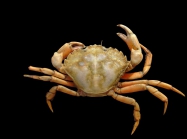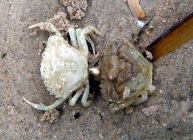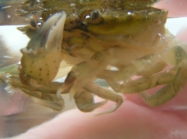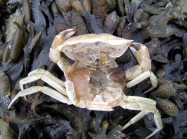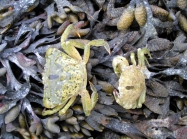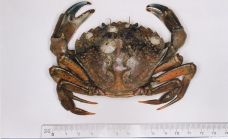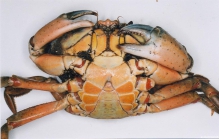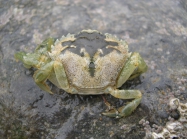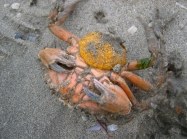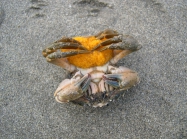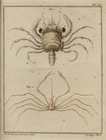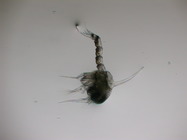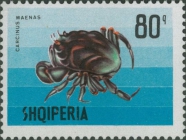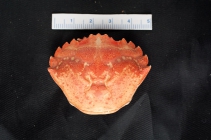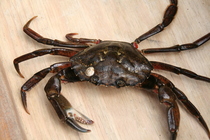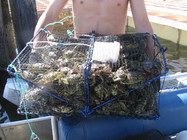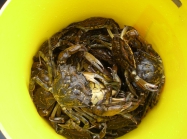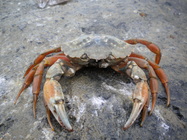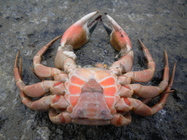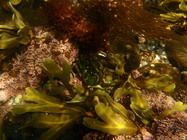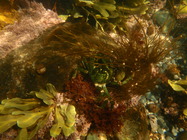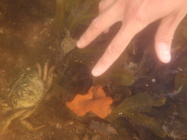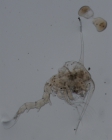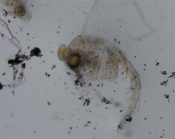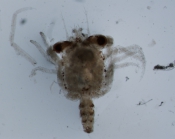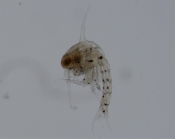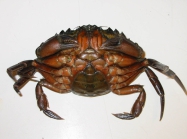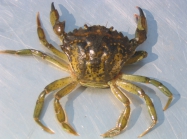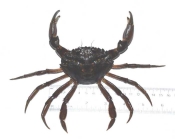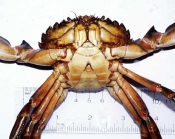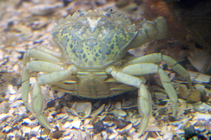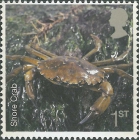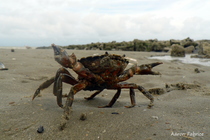
| Introduction | | Search taxa | | Taxon tree | | Taxon match | | Checklist | | Literature | | Stats | | Photogallery | | OBIS Vocab | | Log in |
CaRMS taxon detailsCarcinus maenas (Linnaeus, 1758)
107381 (urn:lsid:marinespecies.org:taxname:107381)
accepted
Species
marine, brackish,
recent + fossil
(of ) Linnaeus, C. (1758). Systema Naturae per regna tria naturae, secundum classes, ordines, genera, species, cum characteribus, differentiis, synonymis, locis. <em>Editio decima, reformata [10th revised edition], vol. 1: 824 pp. Laurentius Salvius: Holmiae.</em> , available online at https://biodiversitylibrary.org/page/726886 [details] Available for editors
Distribution Nova Scotia to Virginia
Distribution Nova Scotia to Virginia [details]
DecaNet eds. (2024). DecaNet. Carcinus maenas (Linnaeus, 1758). Accessed through: Nozères, C., Kennedy, M.K. (Eds.) (2024) Canadian Register of Marine Species at: https://www.marinespecies.org/carms/aphia.php?p=taxdetails&id=107381 on 2024-04-19
Nozères, C., Kennedy, M.K. (Eds.) (2024). Canadian Register of Marine Species. Carcinus maenas (Linnaeus, 1758). Accessed at: https://www.marinespecies.org/carms/aphia.php?p=taxdetails&id=107381 on 2024-04-19
Date action by
original description
(of ) Linnaeus, C. (1758). Systema Naturae per regna tria naturae, secundum classes, ordines, genera, species, cum characteribus, differentiis, synonymis, locis. <em>Editio decima, reformata [10th revised edition], vol. 1: 824 pp. Laurentius Salvius: Holmiae.</em> , available online at https://biodiversitylibrary.org/page/726886 [details] Available for editors
context source (Introduced species) Fofonoff, P.W.; Ruiz, G.M.; Steves, B.; Carlton, J.T. (2014). National Exotic Marine and Estuarine Species Information System (NEMESIS), available online at http://invasions.si.edu/nemesis [details] context source (HKRMS) Kei LWK. & Lau SCK. (1994). Baseline information survey of shelter island - a potential marine park. Final report. Submitted to the Agriculture and Fisheries Department, The Hong Kong SAR Government. [details] context source (Schelde) Maris, T.; Beauchard, O.; Van Damme, S.; Van den Bergh, E.; Wijnhoven, S.; Meire, P. (2013). Referentiematrices en Ecotoopoppervlaktes Annex bij de Evaluatiemethodiek Schelde-estuarium Studie naar “Ecotoopoppervlaktes en intactness index”. <em>Monitor Taskforce Publication Series, 2013-01. NIOZ: Yerseke.</em> 35 pp. (look up in IMIS) [details] context source (BeRMS 2020) Marine Biology Section, Ugent. Belgium. INRAM. Benthic fauna monitoring- SSD - Belgian Science Policy., available online at http://www.vliz.be/projects/inram/imers.php. [details] basis of record Türkay, M. (2001). Decapoda, <B><I>in</I></B>: Costello, M.J. <i>et al.</i> (Ed.) (2001). <i>European register of marine species: a check-list of the marine species in Europe and a bibliography of guides to their identification. Collection Patrimoines Naturels,</i> 50: pp. 284-292 (look up in IMIS) [details] additional source Crosnier, A. (1962). Faune de Madagascar. XVI Crustaces Decapodes: Portunidae. <em>Faune de Madagascar.</em> 16: 1-154, pls. 1-13. [details] Available for editors additional source Muller, Y. (2004). Faune et flore du littoral du Nord, du Pas-de-Calais et de la Belgique: inventaire. [Coastal fauna and flora of the Nord, Pas-de-Calais and Belgium: inventory]. <em>Commission Régionale de Biologie Région Nord Pas-de-Calais: France.</em> 307 pp., available online at http://www.vliz.be/imisdocs/publications/145561.pdf [details] additional source Trott, T. J. (2004). Cobscook Bay inventory: a historical checklist of marine invertebrates spanning 162 years. <em>Northeastern Naturalist.</em> 11, 261-324., available online at http://www.gulfofmaine.org/kb/files/9793/TROTT-Cobscook%20List.pdf page(s): 291 [details] Available for editors additional source Adema, J.P.H.M. (1991). De krabben van Nederland en Belgie (Crustacea, Decapoda, Brachyura) [The crabs of the Netherlands and Belgium (Crustacea, Decapoda, Brachyura)]. <em>Nationaal Natuurhistorisch Museum: Leiden, The Netherlands.</em> ISBN 90-73239-02-8. 244 pp. (look up in IMIS) [details] biology source Tepolt, C. K. (2014). Adaptation in marine invasion: a genetic perspective. <em>Biological Invasions.</em> 17(3): 887-903., available online at https://doi.org/10.1007/s10530-014-0825-8 note: Here, I review evidence for adaptation in marine invasion, considering both quantitative and genetic studies. [details] Available for editors  Present Present  Inaccurate Inaccurate  Introduced: alien Introduced: alien  Containing type locality Containing type locality
From regional or thematic species database
Introduced species impact Australian part of the South Pacific Ocean (Marine Region) Induces novel behavioural or eco-physiological responses [details]Introduced species impact in Australian part of the Great Australian Bight (Marine Region) : Consumes native species (predator or herbivore) [details] Introduced species impact in United States Exclusive Economic Zone (EEZ) : Loss of aquaculture/commercial/recreational harvest or gain [details] Introduced species impact United States part of the North Atlantic Ocean (Marine Region) Consumes native species (predator or herbivore) [details] Introduced species population trend in Madagascar (Nation) : The failure to become established in these warm waters is probably related to temperature tolerances of adult and larval stages. [details] Introduced species population trend in Sri Lanka (Nation) : The failure to become established in these warm waters is probably related to temperature tolerances of adult and larval stages. [details] Introduced species population trend in Myanmar (Nation) : The failure to become established in these warm waters is probably related to temperature tolerances of adult and larval stages. [details] Introduced species population trend in Pakistan (Nation) : The failure to become established in these warm waters is probably related to temperature tolerances of adult and larval stages. [details] Introduced species population trend in Red Sea (IHO Sea Area) : The failure to become established in these warm waters is probably related to temperature tolerances of adult and larval stages. [details] Introduced species remark Canadian part of the North Pacific Ocean (Marine Region) The invasion of the northeast Pacific by C. maenas originated in San Francisco Bay, CA, in 1989 and has primarily spread northward into seasonally cooler waters (Behrens Yamada and Hunt 2000; See and Feist 2010), suggesting warm water temperatures may be limiting southward spread but cold stress is not yet limiting northward spread. [details] Introduced species remark In Australian part of the Exclusive Econmic Zone (EEZ) : On the East and West coasts of North America, and in Australia Carcinus maenas has had serious impacts on shore communities; primarily as one of the chief predators of the intertidal zone. It can affect the survival and recruitment of gastropods, bivalves, other crabs, and probably a wide range of other invertebrates (Vermeij 1982a; Vermeij 1982b; Williams 1984; Grosholz and Ruiz 2002). [details] Introduced species remark In United States Exclusive Economic Zone (EEZ) : It is a major predator of Mercenaria mercenaria (Quahog or Hard Clam) in southern New England (Walton et al. 2001). On the West Coast, Carcinus maenas is regarded as a potential predator on commercially important clams, including introduced Softshell Clams, Japanese Littlenecks (Venerupis philippinarum), and the Mediterranean Mussel (Mytilus galloprovincialis), as well as the native Pacific Littleneck (Leukoma staminea) (Grosholz et al. 2011). [details] Introduced species remark United States part of the North Atlantic Ocean (Marine Region) Here we demonstrated that the pattern of C. maenas displacement from rocky intertidal habitats observed in studies from Southern New England has continued as H. sanguineus populations have expanded northwards, which, given their high abundances, could result in greater disturbance to native communities (Lohrer and Whitlatch 2002a). [details] Introduced species vector dispersal Canadian part of the North Pacific Ocean (Marine Region) Natural dispersal [details] Introduced species vector dispersal in Canadian part of the North Pacific Ocean (Marine Region) : The Green Crab was likely introduced to the West Coast through the live-bait trade, or less likely, in the ballast water of ships (Cohen et al. 1995; Grosholz and Ruiz 1995). [details] Introduced species vector dispersal in United States (Nation) : Natural dispersal [details] Introduced species vector dispersal in United States (Nation) : Research data strongly suggest that the introductions to Oregon, Washington and British Columbia occurred through larval transport via strong ocean currents associated with an unusually large El Nino event in 1997 and 1998. [details] From other sources
Diet Eats other invertebrates. [details]Distribution Nova Scotia to Virginia [details] Habitat Primarily intertidal and shallow subtidal areas, 0-60 m depth, rarely to 200 m, common under rocks and algae, tide pools, marshes and seagrass beds, found in low to full salinity areas. [details]
BIOTIC
Encyclopedia of Marine Life of Britain and Ireland Marine Life Information Network - UK PlanktonNet Image To Barcode of Life (494 barcodes) To Biodiversity Heritage Library (527 publications) To Dyntaxa To European Nucleotide Archive (ENA) To GenBank (16559 nucleotides; 991 proteins) To Global Biotic Interactions (GloBI) To Global Invasive Species Database (GISD) To NMNH Extant Collection (TAX CRT 258383 back) To NMNH Extant Collection (TAX CRT 283069 back) To PESI To USNM Invertebrate Zoology Arthropoda Collection (99 records) To Yale Peabody Museum of Natural History (YPM IZ 071229) To ITIS |
